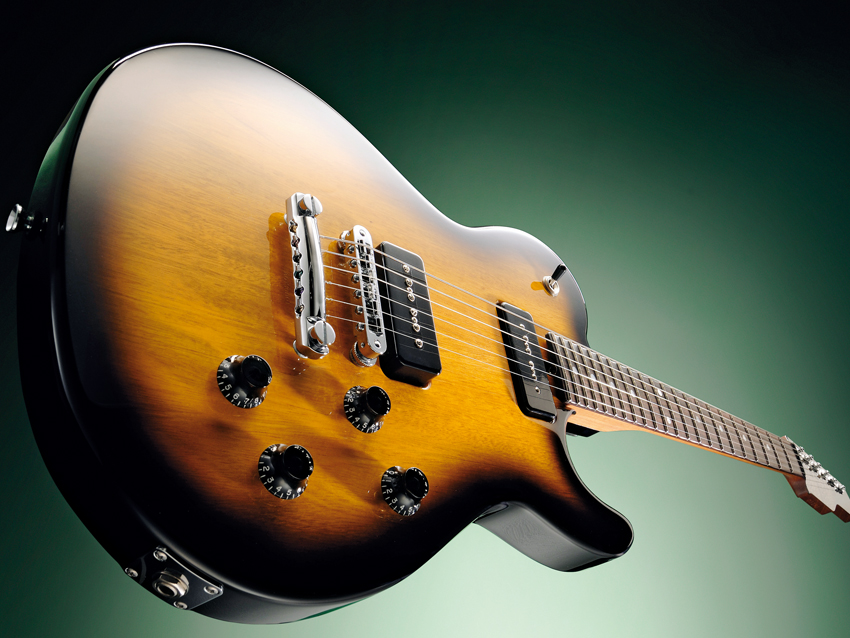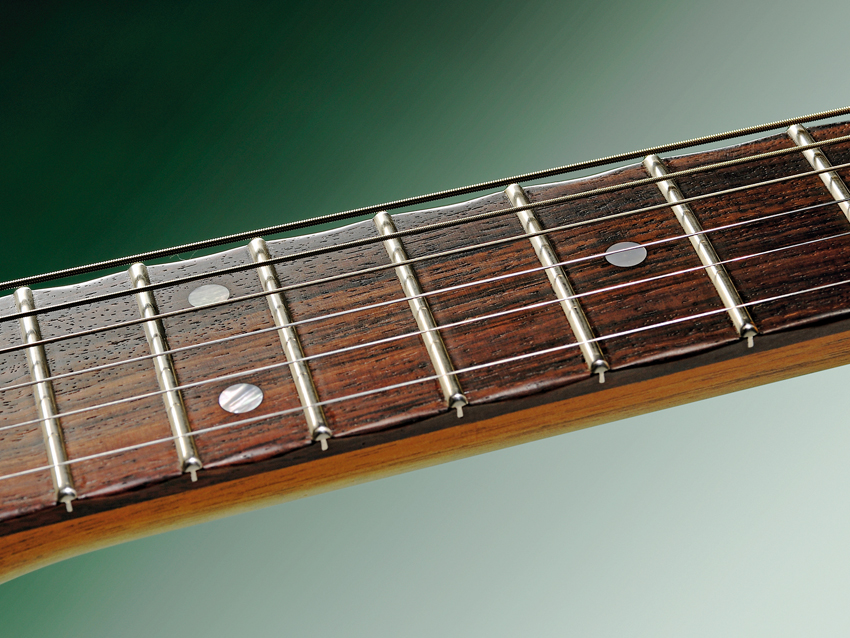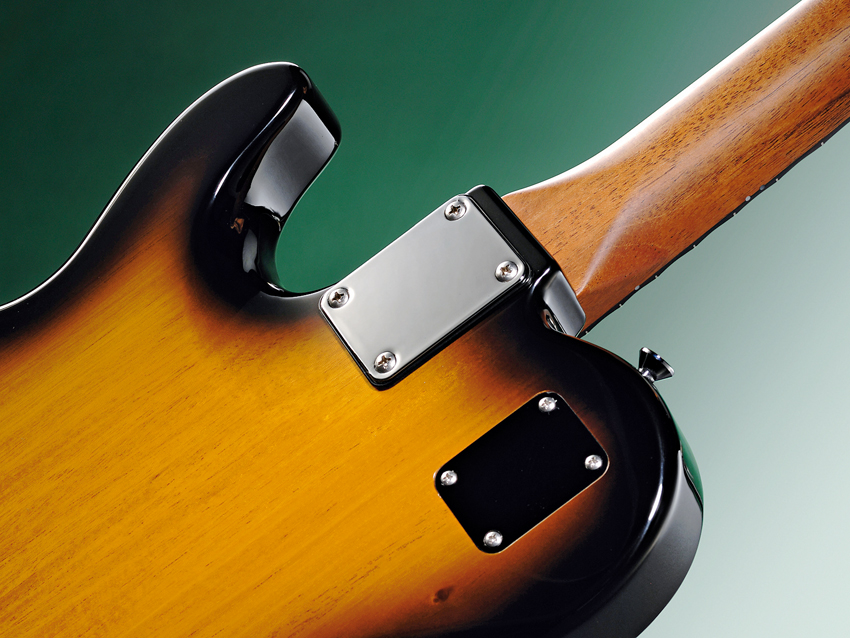MusicRadar Verdict
A mahogany platform with soapbar single-coils, throw in James Tyler's style and you have a near-perfect tone machine.
Pros
- +
Excellent design and build. Evocative and versatile sounds. Truly inspirational neck shape.
Cons
- -
Don't mention the headstock. Not cheap.
MusicRadar's got your back

Tyler Mongoose Special

Tyler Mongoose Special

Tyler Mongoose Special
Back in the mid-nineties, James Tyler built his first Mongoose (aka the Mongoobaster) as a reaction against the superstrat guitars he'd garnered a reputation for in the preceding decade.
Over the years the Mongoose has appealed to many players looking for a different platform (among them studio player/ producer Dan Huff); a sort of Tele-meets-Les Paul that can be ordered in more Tele- or Les Paul-like formats.
One thing that doesn't change is the bolt-on 648mm (25.5-inch scale length) neck, the same throughout the Tyler range. Our review model here illustrates yet another version of this versatile platform: a seemingly simplistic all-mahogany construction with dual soapbar single-coils that puts it - inspiration-wise - in the single-cut, fifties-era Les Paul Special camp.
"It's certainly not a Jr/Special clone, it's more grown-up sounding, with tons of character that even lower-output humbuckers can't match."
Our first impressions are of the guitar's light weight, about a pound lighter than this writer's reference 1957 single-cut Les Paul Junior. With a beautifully old-school two-tone sunburst finish the guitar's edges are solid black and hide the complex construction: the Mongoose is virtually hollow.
The one-piece back is cut-out leaving the sides, strengthening around the control cavity, heel block and a block under the Tone Pros tune-o-matic bridge and stud tailpiece. It's then capped with a two-piece top - the jointing is superb.
Its Tele-inspired shape is far from a copy, being rounder on the base bouts and upper shoulder and with a little more 'air' to the cutaway. The edges are more rounded than either a vintage Tele or Special, and there's a slight rib-cage chamfer while the area under the neckplate is chamfered too - subtle comfort contouring that in the latter case aids upper fret access.
If Tyler's headstock still draws debate after all these years, the necks are universally liked. Again, in terms of profile, there are numerous choices.
Want all the hottest music and gear news, reviews, deals, features and more, direct to your inbox? Sign up here.
While the neck's width remains constant (41mm at the nut, 56mm at the 22nd fret) four profile options - Thin, Standard, Fat and Vee - are offered over the standard 1959 neck we have here that's not as deep overall as the Vee but is deeper than the Fat at the first fret.
There's still a hint of a 'V' to the profile, so the shoulders don't feel overly big, but a big neck it most certainly is: 22.2mm deep at the first, 25mm at the 12th. Yet it's expertly shaped and, combined with the heavily rounded fingerboard edges, feels very old school and very played in.
It also feels unfinished (although it's Tyler's standard eight coat urethane finish) with a dry satin tactile feel that undoubtedly will burnish up after a few gigs. The Indian rosewood fingerboard is again superbly executed with its 'best of all world's' radius that graduates from Gibson (12-inches) at the top to modern Fender (9.5mm) at the nut.
The 'Fat and Tall' fretwire will be on the big side for some (1.4mm high x 2.54mm wide) but it offers superb playability in terms of bends and hammer-on/pull-offs. ('Narrow and Tall' is optional, reducing the width to 2.3mm).
Each fret is superbly finished, the crowns are nicely domed and mirror-like, the edges beautifully rounded. And the 'board just has standard pearl dots to the face and smaller but visible pearl dots to the edge.
Sperzel locking tuners (with staggered post heights so string trees aren't necessary) and Tone Pros bridge and tailpiece signify Tyler's hardware of choice, while pickups are Tyler's own Vintage Soapbars screwed directly to the body with foam cushions to allow height adjustment.
There's no scratchplate to hide any sloppy work and the cut-outs for the pickups are perfectly shaped with slightly rounded edges - precise, exacting craft. With a shoulder-placed three-way toggle selector switch we then have the usual Les Paul-style two volume/two tone control layout and side mounted metal jack socket plate.
The underside of the recessed backplate is, like the cavity, coated with shielding paint. Pots are all 250k ohm and we have a treble bleed capacitor on both volume controls to retain highs as the volumes are reduced. There's nothing new here but it is just proper, pro-spec guitar making.
Strung with 0.010s, a 'manly' string height and a little neck relief there's fight here in terms of set-up. Just as we like it…
Sounds
As we've said many times before, P-90-style single-coils vary dramatically from being slightly warmer 'wider' sounding single-coils to hotter, nastier pickups with as much, if not more, output and grunt than a good PAF.
Tyler's soapbars veer on the cleaner, chimier side and, played clean at lower levels, this Mongoose's back pickup does a good thick Tele-style tone, while the neck pickup is softer-nosed and quite plummy and jazzy.
Both pickups together are hum-cancelling - although pickup hum is always part of the true P-90 experience - and add a well balanced, clipped and hollowed funkier tone.
Winding up the wick and adding a little boost from Blackstar's HT-Dual we're getting into rockier P-90 tonesville. There's a little added rasp to the bridge pickup, and the neck pickup displays more push but still with it's nicely rounded 'nose'.
In fact, A/B'ing it with a variety of old and new P-90-equipped guitars there's noticeably less high-end zing here. Instead there's a lot of woody resonance and no shortage of thumping low end - think less garage punk, more sophisticated valet parking.
The tough set-up means you dig in and there's definitely a 'fifth gear' when you do. The guitar doesn't 'die' in the upper positions where the mid-range thickness and rounded high end make for some stinging but full leads.
It's certainly not a Jr/Special clone, it's more grown-up sounding but with tons of character that even lower-output humbuckers can't match. It's also extremely versatile - especially if you're working in clean-to-crunchy classic genres, although it's no slouch with much more gained modern rock sounds where its resonance makes for some lively and left-field voices.
With its flawless build, acoustic resonance and big, old-school neck, this Mongoose Special is no boutique collector's piece - it would be a terrible waste if it wasn't played extensively.
That's your choice, of course, but whereas some guitars struggle to get beyond their bling-tastic inlays and figured maple tops, this Mongoose is all about simplicity, playability and tone. Yet it's far from a sound- or look-alike guitar.
Tyler's gumbo includes many ingredients and produces a dish that's familiar yet different, and one that any lovers of good Teles and Les Paul Specials should seek out. But, as we've said, with an extensive custom order programme, you can create a more LP- or Tele-inspired Mongoose.
Dave Burrluck is one of the world’s most experienced guitar journalists, who started writing back in the '80s for International Musician and Recording World, co-founded The Guitar Magazine and has been the Gear Reviews Editor of Guitarist magazine for the past two decades. Along the way, Dave has been the sole author of The PRS Guitar Book and The Player's Guide to Guitar Maintenance as well as contributing to numerous other books on the electric guitar. Dave is an active gigging and recording musician and still finds time to make, repair and mod guitars, not least for Guitarist’s The Mod Squad.
